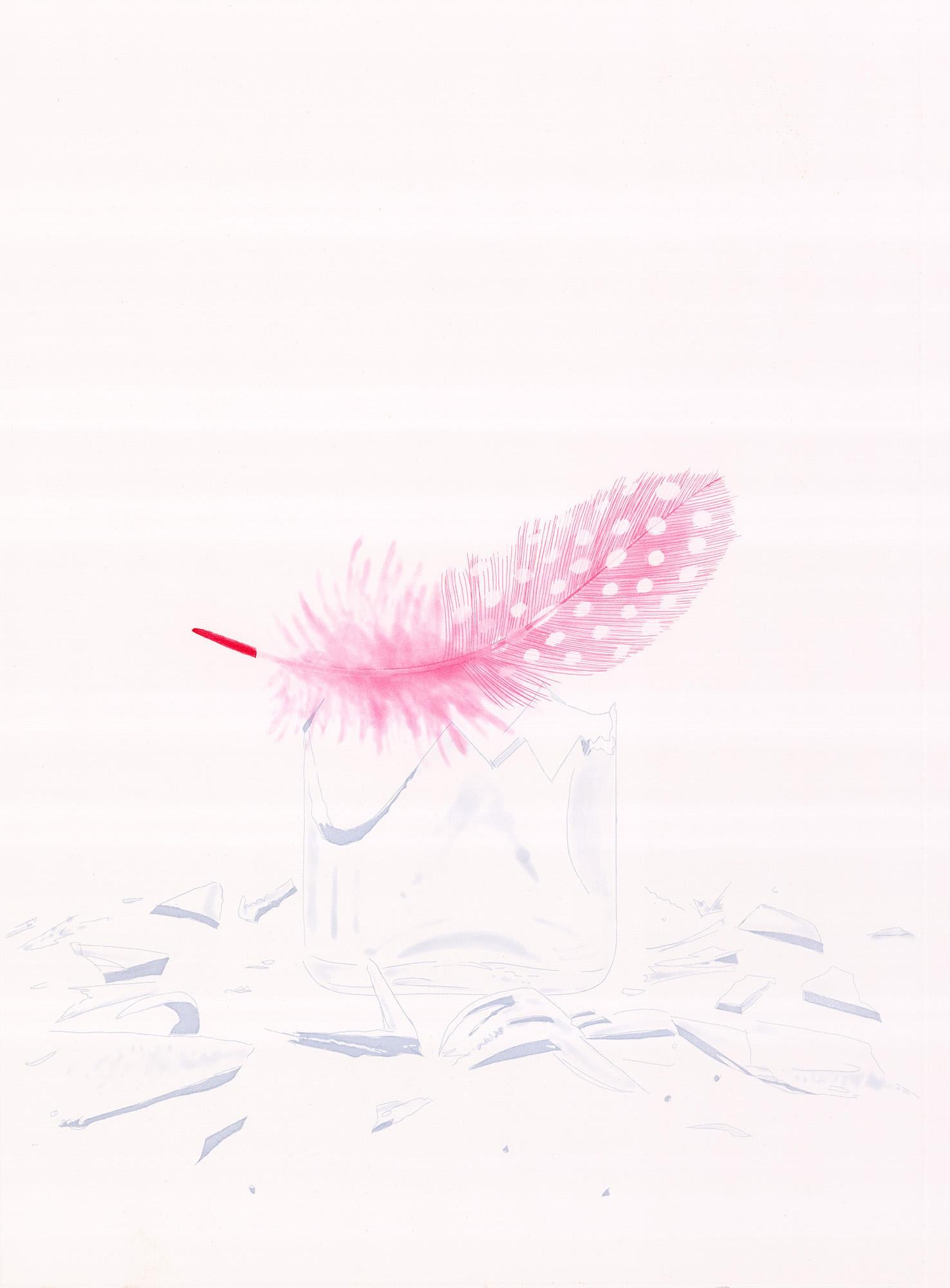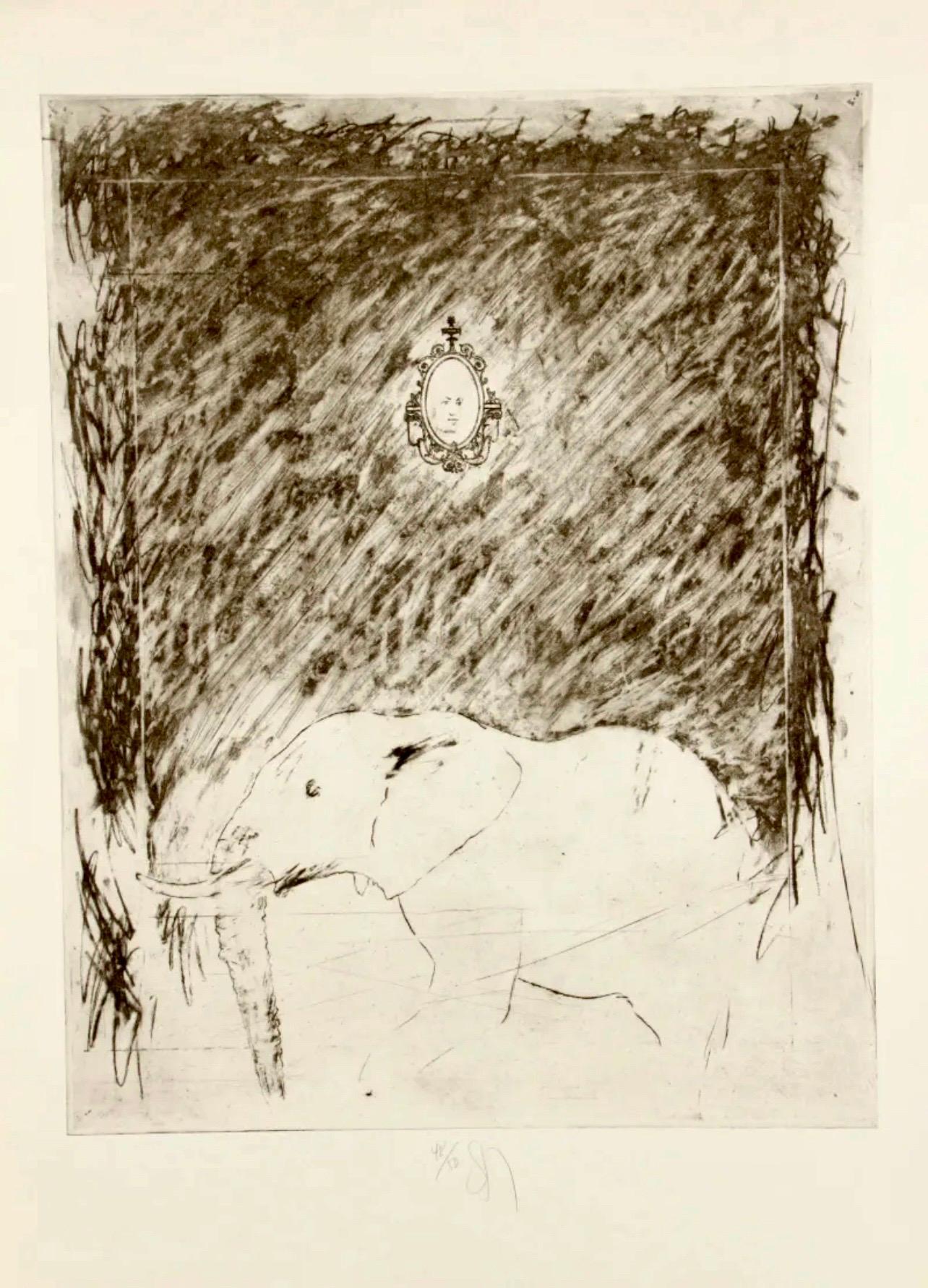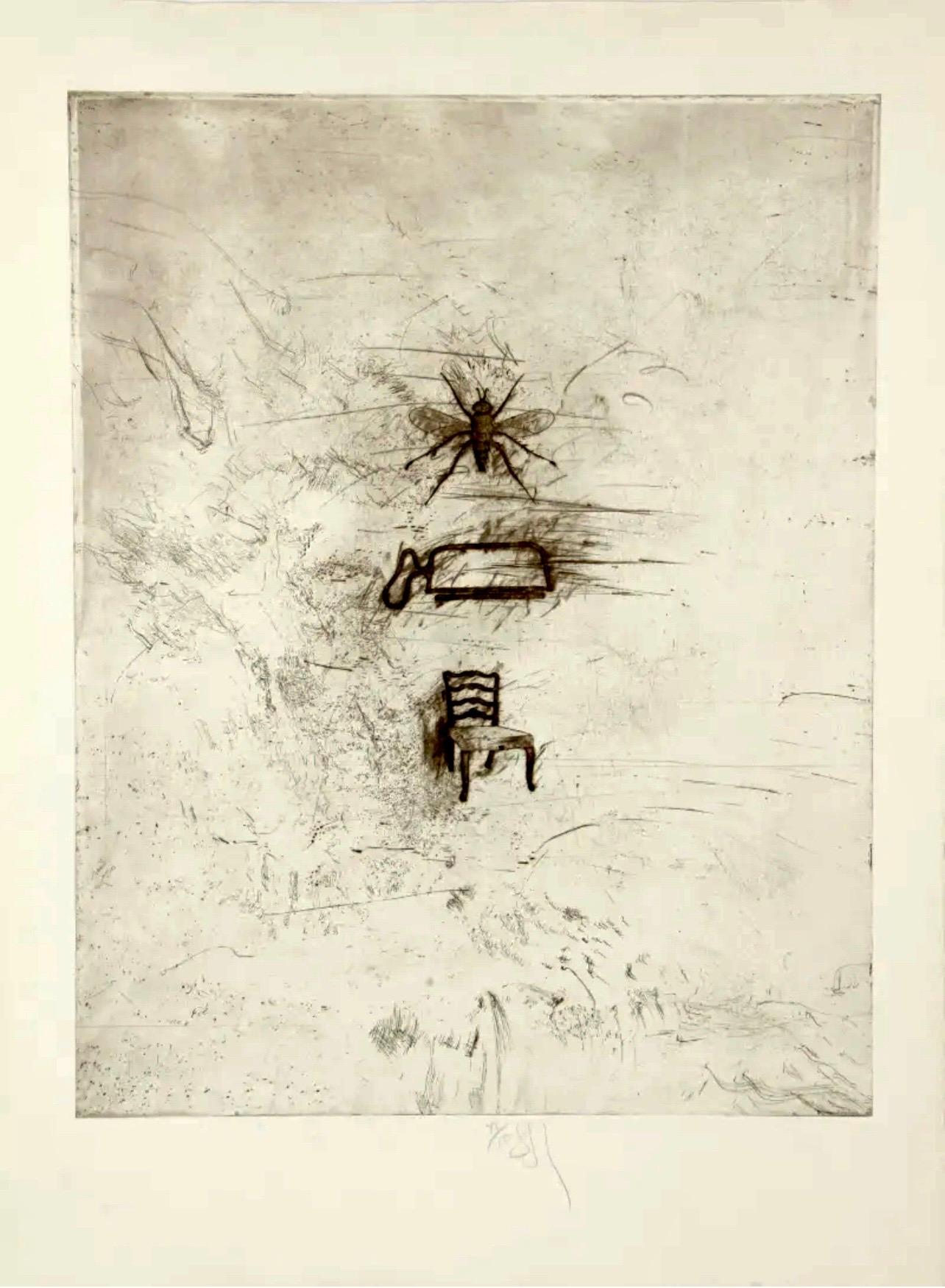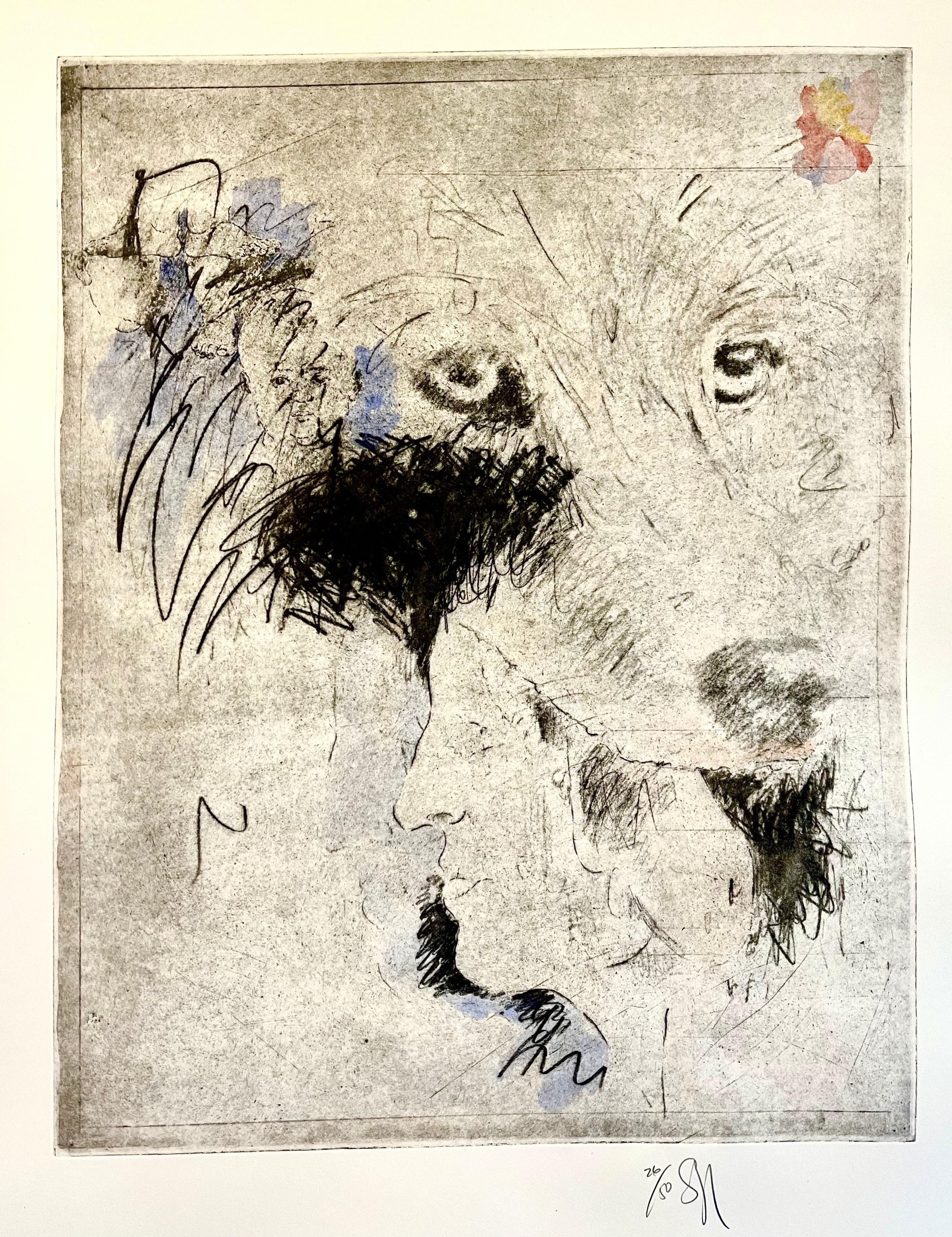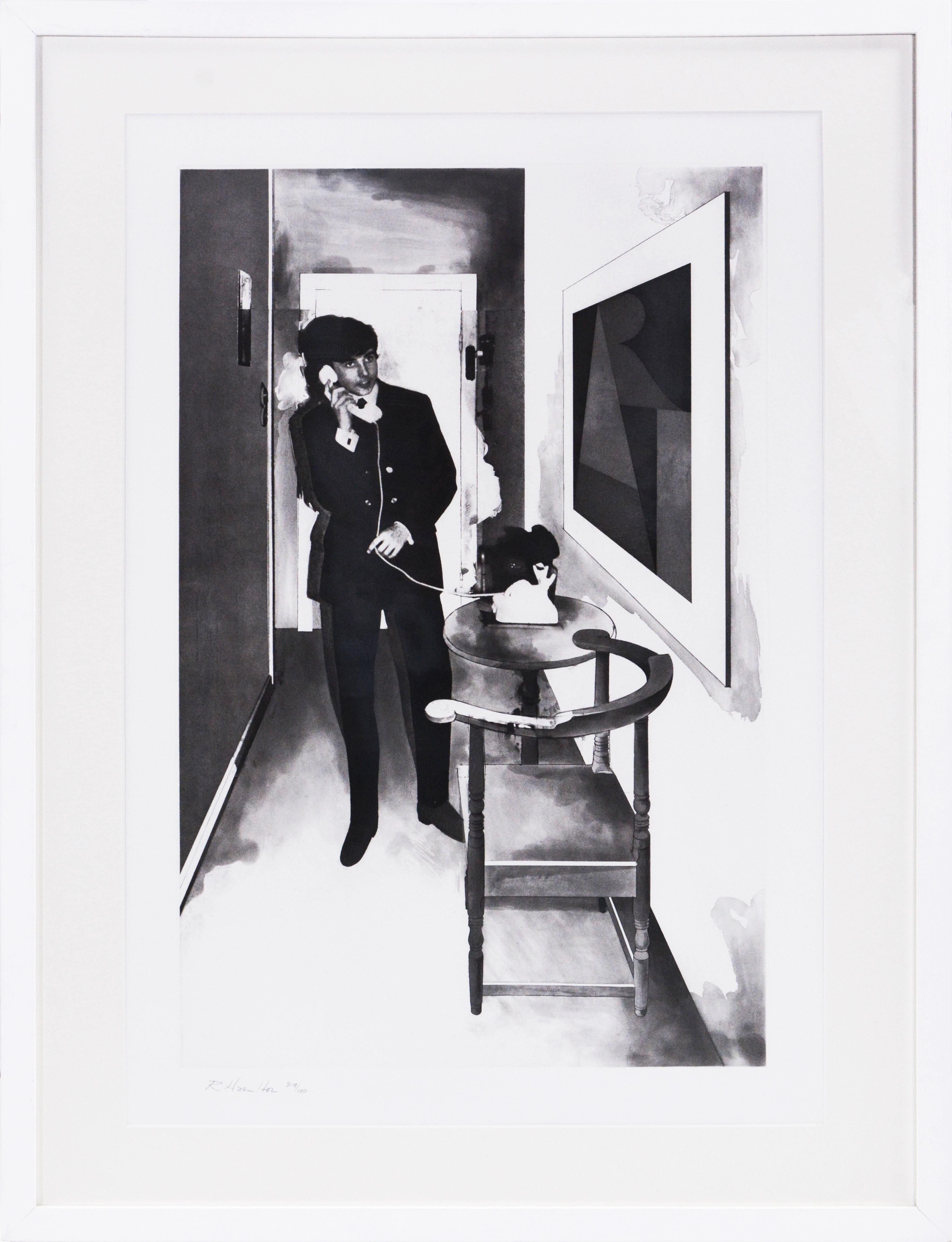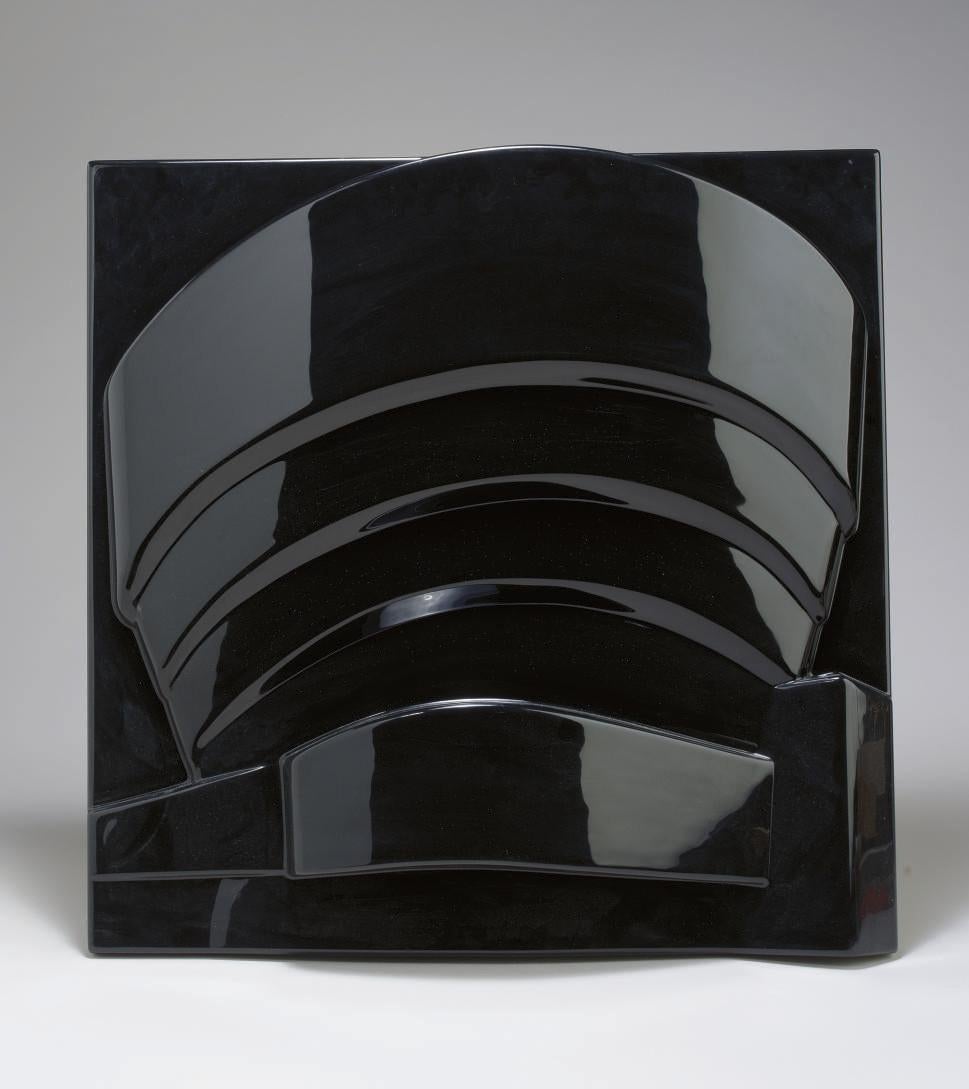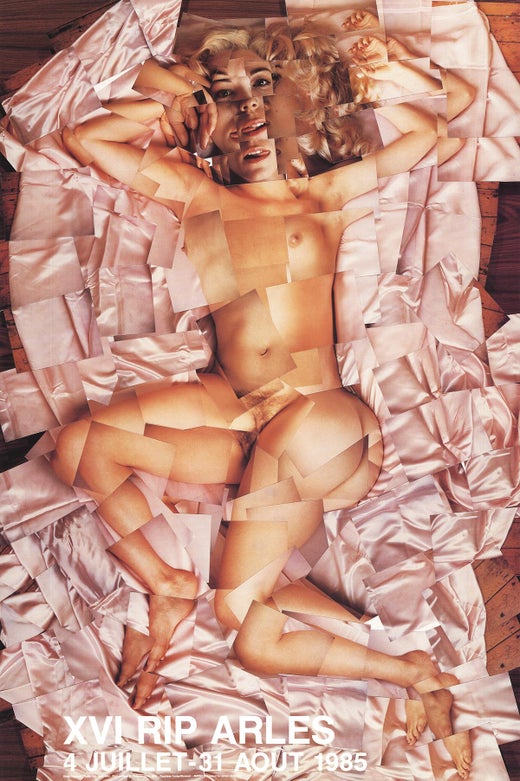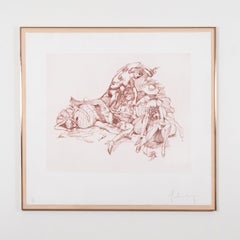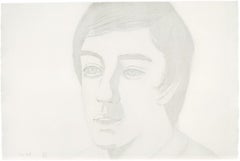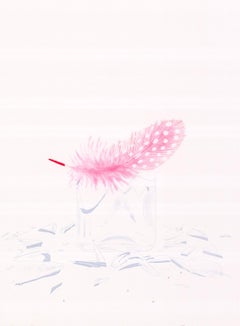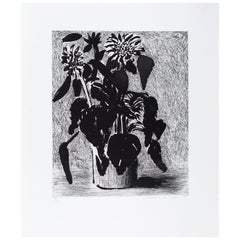
Sunflower II, Etching with aquatint Signed, dated, and numbered, USA, 1995
View Similar Items
David HockneySunflower II, Etching with aquatint Signed, dated, and numbered, USA, 1995 1995
1995
About the Item
- Creator:David Hockney (1937, British)
- Creation Year:1995
- Dimensions:Height: 18 in (45.72 cm)Width: 15 in (38.1 cm)
- Medium:
- Movement & Style:
- Period:
- Framing:Framing Options Available
- Condition:Very good condition.
- Gallery Location:Toronto, CA
- Reference Number:Seller: 1-231stDibs: LU215211585922
David Hockney
The art of David Hockney is always engaging in its pleasant ambiguities: his prints, drawings and paintings are warm but somehow aloof; filled with light yet often dark and brooding in subject; simple, frank and mundane, but also ethereal and complex. The artist’s stature in the contemporary art world is such that, in a 2011 survey of one thousand British painters and sculptors, he was named the most influential British artist of all time.
Hockney grew up in Bradford, in the northern English county of Yorkshire, studying at the Bradford School of Art from 1953 to ’57, and at the Royal College of Art in London from 1959 to 1962. Though he was educated in art at a time when abstraction dominated the field, Hockney stuck resolutely to figurative painting and drawing.
Hockney's early paintings suggest a search for a style, veering from Expressionism to a grotesquerie suggestive of James Ensor. But Hockney found himself almost the moment he arrived in Los Angeles, in 1963. The move from the gray and rainy Britain to a world of bright sunshine and sparkling water brought Hockney a sense of freedom and an artistic epiphany. He would spend most of the next five years in L.A., painting luminous pictures, such as A Bigger Splash (1967), of things that made him happy: swimming pools, manicured lawns, palm trees, stucco buildings and luxuries like shower stalls. Hockney also painted people, almost always his friends. His California portraits such as Beverly Hills Housewife (1966) are considered to be his finest work. They are at once grandly scaled, intimate and poetic.
In the 1970s, Hockney moved back to Britain and spent much of his time on photography and printmaking. He returned to painting in the 1980s, and to subjects like still lifes, seascapes and portraits. Hockney has always been fascinated by the use of technology in art — he’s credited with inventing the technique of joining Polaroid photos in a collage to form a panoramic picture — and has been using the Brush app to paint on an iPad. Because he is prolific and works in a wide range of mediums, Hockney’s art is available at many price points. His consistently striking and provocative work should have a place in any comprehensive collection of contemporary art.
Find original David Hockney art on 1stDibs.
- Study of a MonumentBy Claes OldenburgLocated in Toronto, OntarioClaes Oldenberg (1929-2022) is a Swedish-born American artist, renowned for his contribution to Pop art by way of his iconic soft sculptures and public installations. In 1962, Olden...Category
1970s Pop Art Nude Prints
MaterialsEtching
- Parallel CurvesBy Sol LeWittLocated in Toronto, OntarioSol LeWitt (1928-2007) is an important contributor to the 20th century's most cerebral "isms" notably minimalism and conceptual art. Many of his works were created from elaborate a...Category
Early 2000s Abstract Geometric Abstract Prints
MaterialsEtching, Aquatint, Lithograph
- Seaside StudioBy Robert MotherwellLocated in Toronto, OntarioRobert Motherwell (1915-1991), alongside Jackson Pollock, Mark Rothko, and Willem de Kooning, made up the quartet of American abstract painters that radically defined abstraction and...Category
1990s Abstract Expressionist Abstract Prints
MaterialsEtching, Aquatint
- Reflections IIBy Louise NevelsonLocated in Toronto, OntarioCaviar20 is excited to be offering this evocative print by the inimitable Louise Nevelson - one of the most revered and unique sculptors of the 20th century. Nevelson is renowned for her mysterious and complex artworks. She was an active printmaker, experimenting with different techniques and approaches while working with some of the best print-making studios in the United States. Nevelson, whether working in sculpture or in two dimensions typically had a strict palette; almost exclusively black. While there are iconic works in white, gold, or raw wood, Nevelson almost entirely avoids color. However during the last decade of her life, her palette expands notably with her printmaking. "Reflections II" is an example from her 1983 portfolio, "Reflections I-V" consisting of six large-scale prints. These prints contains signature elements found throughout Nevelson's prints; ripped or collage-like forms as well as the use of fabric, lace and toile in the printing process. However one of the strongest characteristics of the "Reflections" series is her new uninhibited use of color. Here it is used to maximum effect. This work features unexpected elements of tangerine, translucent Prussian blue, and mint green that punctuate her signature layered collage-like composition. Nevelson's late prints are truly some of her best. Over the last few years, there has been tremendous momentum in both interest and appreciation of Nevelson's work. In May of 2021, a new auction record of $1.35 million was established for one of Nevelson's signature white construction sculptures...Category
1980s Abstract Expressionist Abstract Prints
MaterialsEtching, Aquatint
- Purple StripeBy Louise NevelsonLocated in Toronto, OntarioCaviar20 is excited to be offering this evocative print by the inimitable Louise Nevelson - one of the most revered and unique sculptors of the 20th century. Nevelson is renowned for her mysterious and complex artworks. She was an active printmaker, experimenting with different techniques and approaches while working with some of the best print-making studios in the United States and Italy. Many of the leading, ground-breaking American abstract artists experienced success in post-war Europe. Nevelson was notably well-embraced in Italy arguably because of parallels to Arte Povera in her work. She had an important and enduring connection to Italy, beginning with representing America at the Venice Biennale in 1962. Nevelson would then exhibit at the legendary Studio Marconi in Milan during the succeeding decades. This fruitful relationship led Nevelson to start working with Italian printmakers during the 1970s. This impressive aquatint is a paradigm of both the era and Nevelson's later printmaking, notable for its use of metallic elements, color, and collage. This work features unexpected shades of magenta, lime green, and rust, which punctuate her signature monochromatic black forms that sweep the surface of the page creating an intriguing architectural form. This work is an example from Nevelson's 1973 portfolio, "Aquatints Portfolio (B. 116)" which comprised six aquatints with metallic elements. Click here to see another example from this body of work. Over the last few years, there has been tremendous momentum in both interest and appreciation of Nevelson's work. In May of 2021, a new auction record of $1.35 million was established for one of Nevelson's signature white construction sculptures...Category
1970s Abstract Expressionist Abstract Prints
MaterialsEtching, Aquatint
- Reflections IBy Louise NevelsonLocated in Toronto, OntarioCaviar20 is excited to be offering this evocative print by the inimitable Louise Nevelson - one of the most revered and unique sculptors of the 20th century. Nevelson is renowned for her mysterious and complex artworks. She was an active printmaker, experimenting with different techniques and approaches while working with some of the best print-making studios in the United States. Nevelson, whether working in sculpture or in two dimensions typically had a strict palette; almost exclusively black. While there are iconic works in white, gold, or raw wood, Nevelson almost entirely avoids color. However, during the last decade of her life, her palette expands notably with her printmaking. "Reflections I" is an example from her 1983 portfolio, "Reflections I-V" consisting of six large-scale prints. These prints contain signature elements found throughout Nevelson's prints; ripped or collage-like forms as well as the use of fabric, lace, and toile in the printing process. However one of the strongest characteristics of the "Reflections" series is her new uninhibited use of color. Here it is used to maximum effect. This work features unexpected elements of crimson and translucent rose and Prussian blue that punctuate her signature layered collage-like composition. Nevelson's late prints are truly some of her best. Over the last few years, there has been tremendous momentum in both interest and appreciation of Nevelson's work. In May of 2021, a new auction record of $1.35 million was established for one of Nevelson's signature white construction sculptures...Category
1980s Abstract Expressionist Abstract Prints
MaterialsEtching, Aquatint
- Vincent with Open MouthBy Alex KatzLocated in New York, NYAquatint and drypoint 14 3/4 x 22 1/4 inches Edition: 58 Artist Proofs: 8 White German Etching paper Printed by Jennifer Melby, New York Co-published by Brooke Alexander, Inc., New Y...Category
1970s Pop Art Prints and Multiples
MaterialsDrypoint, Aquatint
Price Upon Request - Picasso's Meninas - Richard Hamilton, Aquatint, Pop Art, Contemporary Art, PrintBy Richard HamiltonLocated in London, GBEtching with aquatint, roulette, and drypoint, 1973. Signed in pencil and numbered from the edition of 120. From: Homage to Picasso. Printed on Rives paper by Aldo Crommelynck, Pa...Category
1970s Pop Art Figurative Prints
MaterialsDrypoint, Etching, Aquatint
- Plume - Etching, Aquatint, Contemporary Art, Pop Art, Still Life, RosenquistBy James RosenquistLocated in London, GBFrom 'Glass Wishes'. Signed, titled and dated in pencil. Numbered from the edition of 59. Printed and published by Gemini G.E.L., Los Angeles.Category
1980s Pop Art Still-life Prints
MaterialsEtching, Aquatint
- Large Donald Saff Surrealist Pop Art Aquatint Etching African ElephantBy Donald SaffLocated in Surfside, FLArtist: Donald Saff Medium: Etching with Aquatint, Hand signed and numbered in pencil. Donald Jay Saff (born 12 December 1937) is an artist, art historian, educator, and lecturer, specializing in the fields of contemporary art in addition to American and English horology. Saff was born in Brooklyn, New York. Donald Saff began his undergraduate degree at Queens College, City University of New York, in 1955, initially envisioning a career as an electrical engineer. However, the following year Saff changed his major to art and learned printmaking, to graduate with a B.A. in 1959 and a M.A. in art history from Columbia University in 1960. In the years following, Saff was awarded a M.F.A. from Pratt Institute in 1962 and an Ed.D. in studio art and art history from Columbia University in 1964. In his early career, Saff studied with Robert Goldwater, Robert Branner, Louis Hechenbleikner, and Meyer Schapiro. Saff is primarily known for his work and collaboration with the leading artists of the late-twentieth century, including Robert Rauschenberg, Jim Dine, Roy Lichtenstein, James Rosenquist, Nancy Graves, Philip Pearlstein, and James Turrell. Saff's prolific career is the subject of Marilyn S. Kushner's book, Donald Saff: Art in Collaboration (2010). Saff began his teaching career at Queens College as a lecturer in Art History, Design, and Drawing, from 1961 to 1964. In 1965, Saff was appointed as an associate professor in the visual arts department of the University of South Florida in Tampa, Florida, and became professor and chairman of the visual arts department two years later. In 1971, Saff became the founding dean of the College of Fine Arts at U.S.F., and was awarded the rank of distinguished professor at the university in 1982. Saff was later named dean emeritus by USF in 1989, and distinguished professor emeritus in 1996. In 1999, Saff was awarded the honorary degree of Doctor of Fine Arts at U.S.F. He was appointed the Director of Capital Projects of the Solomon R. Guggenheim Foundation, New York, in 2001, followed by the appointment of Senior Curator of Prints and Drawings in 2002. In 1968, Saff founded Graphicstudio at U.S.F. through funding by a seed grant from the Florida Arts Council and community supporters; the following year, Philip Pearlstein was the first artist invited to Graphicstudio to collaborate with Saff and his team. Saff became Founding Dean of the College of Fine Arts at U.S.F. in 1971. Under Saff's directorship, Graphicstudio collaborated with artists such as James Rosenquist, Robert Rauschenberg, Richard Anuszkiewicz, Shusaku Arakawa, Jim Dine, Lee Friedlander, Nancy Graves, Ed Ruscha, and Roy Lichtenstein. The collection of Graphicstudio is archived in the National Gallery of Art in Washington, D.C. Graphicstudio was founded by Dr. Donald Saff as part of the renaissance in American printmaking in the 1960s, in the company of studios such as ULAE, Tamarind, and Gemini GEL. This renaissance brought artists involved in the Pop art movement, such as Robert Rauschenberg, James Rosenquist, and Jim Dine, together with a growing number of trained printmakers from around the world. After Saff retired from U.S.F., he continued to collaborate with these artists, as well as James Turrell, at Saff Tech Arts in Oxford, Maryland, which was established in 1991. While Saff and Rauschenberg were traveling in China, Rauschenberg conceived of the Rauschenberg Overseas Culture Interchange (ROCI) in 1982, which began in 1984 with Saff as the artistic director. Saff travelled to over twenty countries and met with poets and writers in order to decide which were the most appropriate venues for the show and prepare for Rauschenberg's visit and exhibition. In recent years, Saff has continued to lecture and write on art and the history and mechanics of nineteenth-century clocks; in particular, the work of Charles Fasoldt, in addition to the development of time distribution from the Harvard College Observatory, and the horological innovations of Richard F. Bond. He has lectured on Fasoldt for the Antiquarian Horological Association in Cincinnati, OH (2001), the National Association of Watch and Clock Collectors in Pittsburgh, PA, and Anheim, CA (2003), and at the 26th Annual Ward Francillon Time Symposium in Houston, TX (2004), among other venues. Saff continues to work with the Royal Observatory in Greenwich, collaborating with Jonathan Betts and Rory McEvoy, on the trials of Burgess Clock B. (See "Honors.") Exhibitions Saff's individual work spans across his career of collaborative art. As early as 1965, Saff produced Duino Elegies, a print suite that was published and exhibited by Martin Gordon Gallery in New York and at the Galleria Academia in Rome; it was acquired by the Library of Congress, the Brooklyn Museum, and Lessing Rosenwald. Saff also collaborated with printers Galli and Arduini in Urbino to create print suites Breezes (1969), exhibited and published by the Martin Gordon Gallery. Additionally, Saff collaborated with Galli on print suites Paradise Lost (1970) and Numbers (1972), the former printed in Tampa, FL, and exhibited at the Martin Gordon Gallery, the University of South Florida Gallery, the Toronto Art Gallery, and the Loch Haven Art Center, FL. Numbers was exhibited at Multiples Gallery, New York. In 1979, Saff produced print suite Fables that was published and exhibited by the Getler/Pall Gallery in New York, followed by the print suite Constellations (1980), which was also exhibited at the Tom Lutrell Gallery in San Francisco. In 1981, Saff had solo exhibitions of his artwork in the Galleria d'Arte Moderna in Udine, Italy, Youngstown State University, OH, the Leo Castelli Gallery, NY, and in "Recent Acquisitions" at The Museum of Modern Art, NY. Additionally, Saff had solo exhibitions at Dyansen Gallery, NY (1982), at I. Feldman Gallery, Sarasota (1983), and at Edison Community College, FL (1988). In 1989, the retrospective Donald Saff: Mixed Metaphors, 1956–1989 was held at the Tampa Museum of Art and traveled to the Virginia Beach Center for the Arts, followed by his solo exhibition Winged Metaphors: Sculpture and Prints by Donald Saff at the Barbara Gillman Gallery in Miami later that year. In 1997, Brenau University Galleries exhibits Poetics: The Work of Donald Saff in Gainesville, GA. The same year, the Tampa Museum of Art exhibited Donald Saff/Robert Rauschenberg: In Collaboration. Finally, the Academy Art Museum in Easton, MD, exhibited Donald Saff: Gravity and Constellations; Selected Works in 2006. Honors Saff was awarded a Teaching Fellowship at Queens College (1960), a Yaddo Fellowship, Saratoga Springs, NY (1963), and Fulbright Fellowship (1964) to Italy where he studied at Istituto Statale di Belle Arti. While in Urbino, Saff met lifelong friend and colleague Deli Sacilotto, with whom he would co-author Printmaking: History and Process (1978) and Screenprinting: History and Process (1979). He received the Governor's Award for the Arts from the State of Florida in 1973, and was awarded the Florida Endowment for the Arts Individual Artist Grant in 1980. In 1997, Saff was awarded the title "Printmaker Emeritus" by the 25th Southern Graphics Council Conference in Tampa, F.L. In 2002, he was appointed as Visiting Distinguished Professor of Rhode Island School of Design. In April 2015, Saff was awarded a certificate from the Guinness World Records for his work on completing the world's most accurate pendulum clock, "Clock B", which was started by Martin Burgess in 1975. The official title awarded by Guinness World Records, as "the most accurate mechanical clock with a pendulum...Category
1980s Pop Art Figurative Prints
MaterialsAquatint, Etching
- Large Donald Saff Surrealist Pop Art Aquatint Etching Bee, Chair, PotBy Donald SaffLocated in Surfside, FLArtist: Donald Saff Medium: Etching with Aquatint, Hand signed and numbered in pencil Donald Jay Saff (born 12 December 1937) is an artist, art historian, educator, and lecturer, specializing in the fields of contemporary art in addition to American and English horology. Saff was born in Brooklyn, New York. Donald Saff began his undergraduate degree at Queens College, City University of New York, in 1955, initially envisioning a career as an electrical engineer. However, the following year Saff changed his major to art and learned printmaking, to graduate with a B.A. in 1959 and a M.A. in art history from Columbia University in 1960. In the years following, Saff was awarded a M.F.A. from Pratt Institute in 1962 and an Ed.D. in studio art and art history from Columbia University in 1964. In his early career, Saff studied with Robert Goldwater, Robert Branner, Louis Hechenbleikner, and Meyer Schapiro. Saff is primarily known for his work and collaboration with the leading artists of the late-twentieth century, including Robert Rauschenberg, Jim Dine, Roy Lichtenstein, James Rosenquist, Nancy Graves, Philip Pearlstein, and James Turrell. Saff's prolific career is the subject of Marilyn S. Kushner's book, Donald Saff: Art in Collaboration (2010). Saff began his teaching career at Queens College as a lecturer in Art History, Design, and Drawing, from 1961 to 1964. In 1965, Saff was appointed as an associate professor in the visual arts department of the University of South Florida in Tampa, Florida, and became professor and chairman of the visual arts department two years later. In 1971, Saff became the founding dean of the College of Fine Arts at U.S.F., and was awarded the rank of distinguished professor at the university in 1982. Saff was later named dean emeritus by USF in 1989, and distinguished professor emeritus in 1996. In 1999, Saff was awarded the honorary degree of Doctor of Fine Arts at U.S.F. He was appointed the Director of Capital Projects of the Solomon R. Guggenheim Foundation, New York, in 2001, followed by the appointment of Senior Curator of Prints and Drawings in 2002. In 1968, Saff founded Graphicstudio at U.S.F. through funding by a seed grant from the Florida Arts Council and community supporters; the following year, Philip Pearlstein was the first artist invited to Graphicstudio to collaborate with Saff and his team. Saff became Founding Dean of the College of Fine Arts at U.S.F. in 1971. Under Saff's directorship, Graphicstudio collaborated with artists such as James Rosenquist, Robert Rauschenberg, Richard Anuszkiewicz, Shusaku Arakawa, Jim Dine, Lee Friedlander, Nancy Graves, Ed Ruscha, and Roy Lichtenstein. The collection of Graphicstudio is archived in the National Gallery of Art in Washington, D.C. Graphicstudio was founded by Dr. Donald Saff as part of the renaissance in American printmaking in the 1960s, in the company of studios such as ULAE, Tamarind, and Gemini GEL. This renaissance brought artists involved in the Pop art movement, such as Robert Rauschenberg, James Rosenquist, and Jim Dine, together with a growing number of trained printmakers from around the world. After Saff retired from U.S.F., he continued to collaborate with these artists, as well as James Turrell, at Saff Tech Arts in Oxford, Maryland, which was established in 1991. While Saff and Rauschenberg were traveling in China, Rauschenberg conceived of the Rauschenberg Overseas Culture Interchange (ROCI) in 1982, which began in 1984 with Saff as the artistic director. Saff travelled to over twenty countries and met with poets and writers in order to decide which were the most appropriate venues for the show and prepare for Rauschenberg's visit and exhibition. In recent years, Saff has continued to lecture and write on art and the history and mechanics of nineteenth-century clocks; in particular, the work of Charles Fasoldt, in addition to the development of time distribution from the Harvard College Observatory, and the horological innovations of Richard F. Bond. He has lectured on Fasoldt for the Antiquarian Horological Association in Cincinnati, OH (2001), the National Association of Watch and Clock Collectors in Pittsburgh, PA, and Anheim, CA (2003), and at the 26th Annual Ward Francillon Time Symposium in Houston, TX (2004), among other venues. Saff continues to work with the Royal Observatory in Greenwich, collaborating with Jonathan Betts and Rory McEvoy, on the trials of Burgess Clock B. (See "Honors.") Exhibitions Saff's individual work spans across his career of collaborative art. As early as 1965, Saff produced Duino Elegies, a print suite that was published and exhibited by Martin Gordon Gallery in New York and at the Galleria Academia in Rome; it was acquired by the Library of Congress, the Brooklyn Museum, and Lessing Rosenwald. Saff also collaborated with printers Galli and Arduini in Urbino to create print suites Breezes (1969), exhibited and published by the Martin Gordon Gallery. Additionally, Saff collaborated with Galli on print suites Paradise Lost (1970) and Numbers (1972), the former printed in Tampa, FL, and exhibited at the Martin Gordon Gallery, the University of South Florida Gallery, the Toronto Art Gallery, and the Loch Haven Art Center, FL. Numbers was exhibited at Multiples Gallery, New York. In 1979, Saff produced print suite Fables that was published and exhibited by the Getler/Pall Gallery in New York, followed by the print suite Constellations (1980), which was also exhibited at the Tom Lutrell Gallery in San Francisco. In 1981, Saff had solo exhibitions of his artwork in the Galleria d'Arte Moderna in Udine, Italy, Youngstown State University, OH, the Leo Castelli Gallery, NY, and in "Recent Acquisitions" at The Museum of Modern Art, NY. Additionally, Saff had solo exhibitions at Dyansen Gallery, NY (1982), at I. Feldman Gallery, Sarasota (1983), and at Edison Community College, FL (1988). In 1989, the retrospective Donald Saff: Mixed Metaphors, 1956–1989 was held at the Tampa Museum of Art and traveled to the Virginia Beach Center for the Arts, followed by his solo exhibition Winged Metaphors: Sculpture and Prints by Donald Saff at the Barbara Gillman Gallery in Miami later that year. In 1997, Brenau University Galleries exhibits Poetics: The Work of Donald Saff in Gainesville, GA. The same year, the Tampa Museum of Art exhibited Donald Saff/Robert Rauschenberg: In Collaboration. Finally, the Academy Art Museum in Easton, MD, exhibited Donald Saff: Gravity and Constellations; Selected Works in 2006. Honors Saff was awarded a Teaching Fellowship at Queens College (1960), a Yaddo Fellowship, Saratoga Springs, NY (1963), and Fulbright Fellowship (1964) to Italy where he studied at Istituto Statale di Belle Arti. While in Urbino, Saff met lifelong friend and colleague Deli Sacilotto, with whom he would co-author Printmaking: History and Process (1978) and Screenprinting: History and Process (1979). He received the Governor's Award for the Arts from the State of Florida in 1973, and was awarded the Florida Endowment for the Arts Individual Artist Grant in 1980. In 1997, Saff was awarded the title "Printmaker Emeritus" by the 25th Southern Graphics Council Conference in Tampa, F.L. In 2002, he was appointed as Visiting Distinguished Professor of Rhode Island School of Design. In April 2015, Saff was awarded a certificate from the Guinness World Records for his work on completing the world's most accurate pendulum clock, "Clock B", which was started by Martin Burgess in 1975. The official title awarded by Guinness World Records, as "the most accurate mechanical clock with a pendulum...Category
1980s Pop Art Figurative Prints
MaterialsEtching, Aquatint
- Large Donald Saff Surrealist Pop Art Aquatint Etching Wolf, ManBy Donald SaffLocated in Surfside, FLArtist: Donald Saff Title: Wolf and Man Year: 1980 Medium: Etching with Aquatint, Hand signed and numbered in pencil Edition: 50 39 in. x 27.5 in. Donald Jay Saff (born 12 December 1937) is an artist, art historian, educator, and lecturer, specializing in the fields of contemporary art in addition to American and English horology. Saff was born in Brooklyn, New York. Donald Saff began his undergraduate degree at Queens College, City University of New York, in 1955, initially envisioning a career as an electrical engineer. However, the following year Saff changed his major to art and learned printmaking, to graduate with a B.A. in 1959 and a M.A. in art history from Columbia University in 1960. In the years following, Saff was awarded a M.F.A. from Pratt Institute in 1962 and an Ed.D. in studio art and art history from Columbia University in 1964. In his early career, Saff studied with Robert Goldwater, Robert Branner, Louis Hechenbleikner, and Meyer Schapiro. Saff is primarily known for his work and collaboration with the leading artists of the late-twentieth century, including Robert Rauschenberg, Jim Dine, Roy Lichtenstein, James Rosenquist, Nancy Graves, Philip Pearlstein, and James Turrell. Saff's prolific career is the subject of Marilyn S. Kushner's book, Donald Saff: Art in Collaboration (2010). Saff began his teaching career at Queens College as a lecturer in Art History, Design, and Drawing, from 1961 to 1964. In 1965, Saff was appointed as an associate professor in the visual arts department of the University of South Florida in Tampa, Florida, and became professor and chairman of the visual arts department two years later. In 1971, Saff became the founding dean of the College of Fine Arts at U.S.F., and was awarded the rank of distinguished professor at the university in 1982. Saff was later named dean emeritus by USF in 1989, and distinguished professor emeritus in 1996. In 1999, Saff was awarded the honorary degree of Doctor of Fine Arts at U.S.F. He was appointed the Director of Capital Projects of the Solomon R. Guggenheim Foundation, New York, in 2001, followed by the appointment of Senior Curator of Prints and Drawings in 2002. In 1968, Saff founded Graphicstudio at U.S.F. through funding by a seed grant from the Florida Arts Council and community supporters; the following year, Philip Pearlstein was the first artist invited to Graphicstudio to collaborate with Saff and his team. Saff became Founding Dean of the College of Fine Arts at U.S.F. in 1971. Under Saff's directorship, Graphicstudio collaborated with artists such as James Rosenquist, Robert Rauschenberg, Richard Anuszkiewicz, Shusaku Arakawa, Jim Dine, Lee Friedlander, Nancy Graves, Ed Ruscha, and Roy Lichtenstein. The collection of Graphicstudio is archived in the National Gallery of Art in Washington, D.C. Graphicstudio was founded by Dr. Donald Saff as part of the renaissance in American printmaking in the 1960s, in the company of studios such as ULAE, Tamarind, and Gemini GEL. This renaissance brought artists involved in the Pop art movement, such as Robert Rauschenberg, James Rosenquist, and Jim Dine, together with a growing number of trained printmakers from around the world. After Saff retired from U.S.F., he continued to collaborate with these artists, as well as James Turrell, at Saff Tech Arts in Oxford, Maryland, which was established in 1991. While Saff and Rauschenberg were traveling in China, Rauschenberg conceived of the Rauschenberg Overseas Culture Interchange (ROCI) in 1982, which began in 1984 with Saff as the artistic director. Saff travelled to over twenty countries and met with poets and writers in order to decide which were the most appropriate venues for the show and prepare for Rauschenberg's visit and exhibition. In recent years, Saff has continued to lecture and write on art and the history and mechanics of nineteenth-century clocks; in particular, the work of Charles Fasoldt, in addition to the development of time distribution from the Harvard College Observatory, and the horological innovations of Richard F. Bond. He has lectured on Fasoldt for the Antiquarian Horological Association in Cincinnati, OH (2001), the National Association of Watch and Clock Collectors in Pittsburgh, PA, and Anheim, CA (2003), and at the 26th Annual Ward Francillon Time Symposium in Houston, TX (2004), among other venues. Saff continues to work with the Royal Observatory in Greenwich, collaborating with Jonathan Betts and Rory McEvoy, on the trials of Burgess Clock B. (See "Honors.") Exhibitions Saff's individual work spans across his career of collaborative art. As early as 1965, Saff produced Duino Elegies, a print suite that was published and exhibited by Martin Gordon Gallery in New York and at the Galleria Academia in Rome; it was acquired by the Library of Congress, the Brooklyn Museum, and Lessing Rosenwald. Saff also collaborated with printers Galli and Arduini in Urbino to create print suites Breezes (1969), exhibited and published by the Martin Gordon Gallery. Additionally, Saff collaborated with Galli on print suites Paradise Lost (1970) and Numbers (1972), the former printed in Tampa, FL, and exhibited at the Martin Gordon Gallery, the University of South Florida Gallery, the Toronto Art Gallery, and the Loch Haven Art Center, FL. Numbers was exhibited at Multiples Gallery, New York. In 1979, Saff produced print suite Fables that was published and exhibited by the Getler/Pall Gallery in New York, followed by the print suite Constellations (1980), which was also exhibited at the Tom Lutrell Gallery in San Francisco. In 1981, Saff had solo exhibitions of his artwork in the Galleria d'Arte Moderna in Udine, Italy, Youngstown State University, OH, the Leo Castelli Gallery, NY, and in "Recent Acquisitions" at The Museum of Modern Art, NY. Additionally, Saff had solo exhibitions at Dyansen Gallery, NY (1982), at I. Feldman Gallery, Sarasota (1983), and at Edison Community College, FL (1988). In 1989, the retrospective Donald Saff: Mixed Metaphors, 1956–1989 was held at the Tampa Museum of Art and traveled to the Virginia Beach Center for the Arts, followed by his solo exhibition Winged Metaphors: Sculpture and Prints by Donald Saff at the Barbara Gillman Gallery in Miami later that year. In 1997, Brenau University Galleries exhibits Poetics: The Work of Donald Saff in Gainesville, GA. The same year, the Tampa Museum of Art exhibited Donald Saff/Robert Rauschenberg: In Collaboration. Finally, the Academy Art Museum in Easton, MD, exhibited Donald Saff: Gravity and Constellations; Selected Works in 2006. Honors Saff was awarded a Teaching Fellowship at Queens College (1960), a Yaddo Fellowship, Saratoga Springs, NY (1963), and Fulbright Fellowship (1964) to Italy where he studied at Istituto Statale di Belle Arti. While in Urbino, Saff met lifelong friend and colleague Deli Sacilotto, with whom he would co-author Printmaking: History and Process (1978) and Screenprinting: History and Process (1979). He received the Governor's Award for the Arts from the State of Florida in 1973, and was awarded the Florida Endowment for the Arts Individual Artist Grant in 1980. In 1997, Saff was awarded the title "Printmaker Emeritus" by the 25th Southern Graphics Council Conference in Tampa, F.L. In 2002, he was appointed as Visiting Distinguished Professor of Rhode Island School of Design. In April 2015, Saff was awarded a certificate from the Guinness World Records for his work on completing the world's most accurate pendulum clock, "Clock B", which was started by Martin Burgess in 1975. The official title awarded by Guinness World Records, as "the most accurate mechanical clock with a pendulum...Category
1980s Pop Art Figurative Prints
MaterialsEtching, Aquatint


